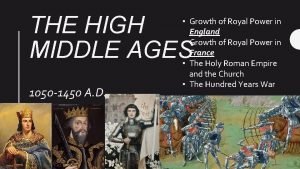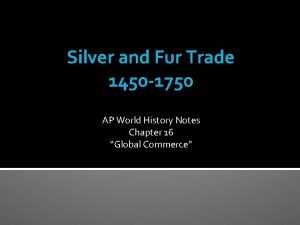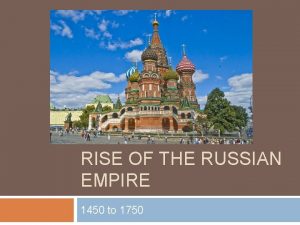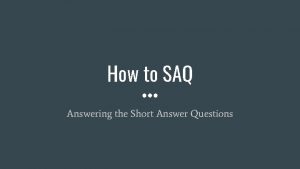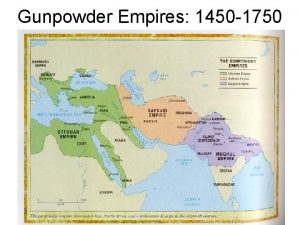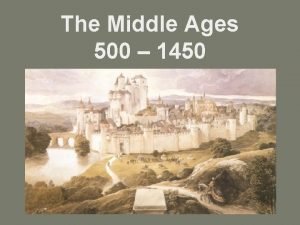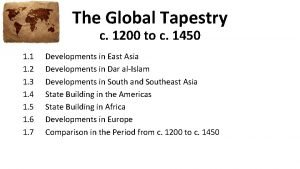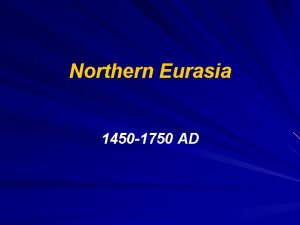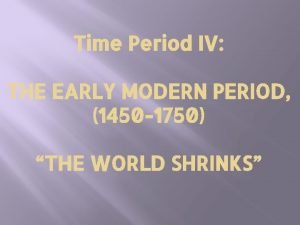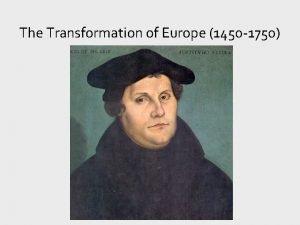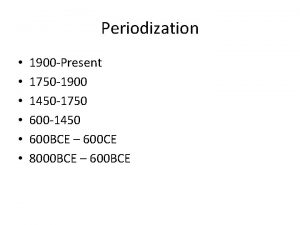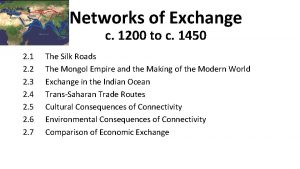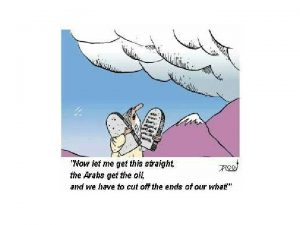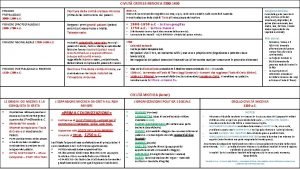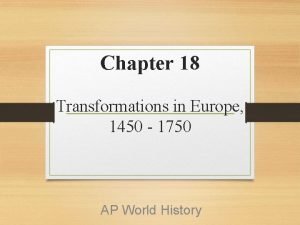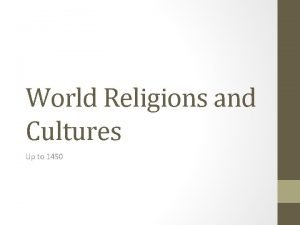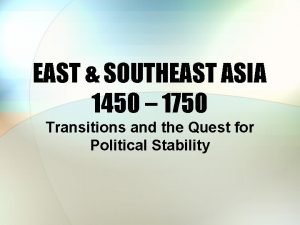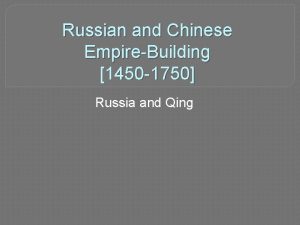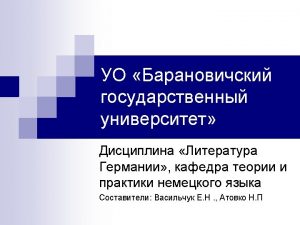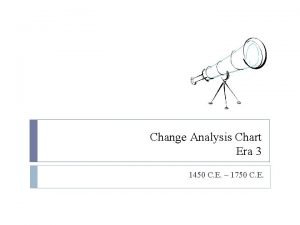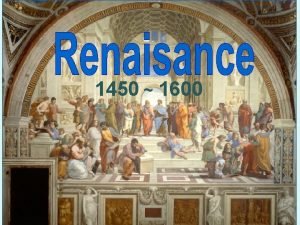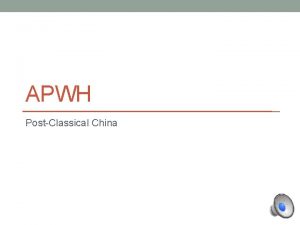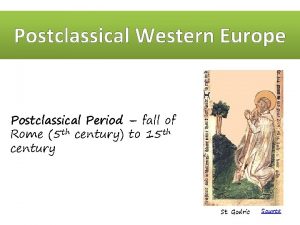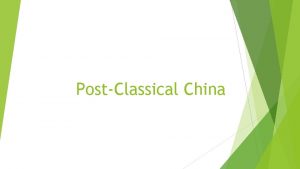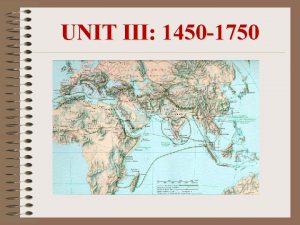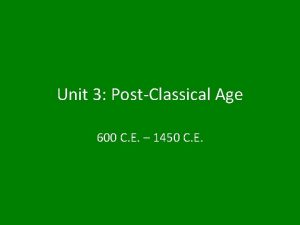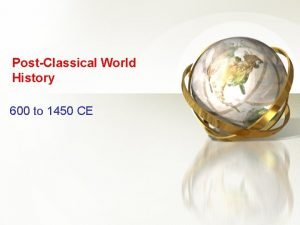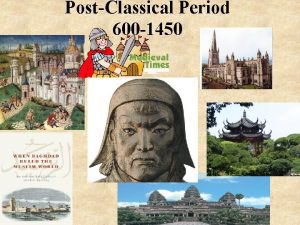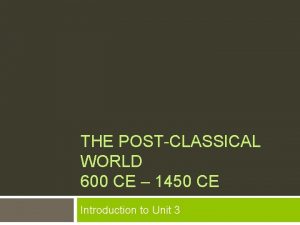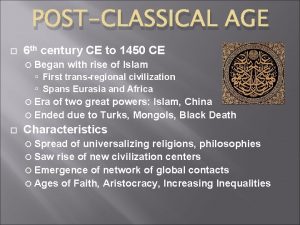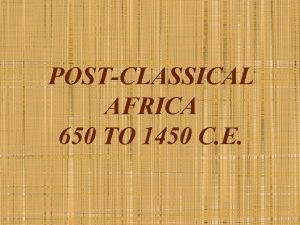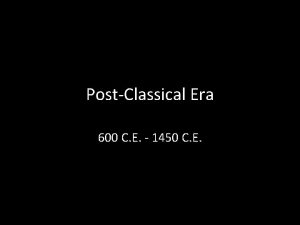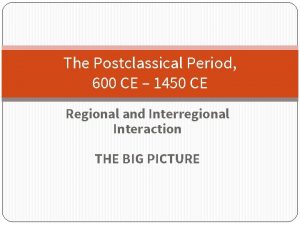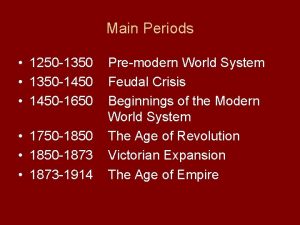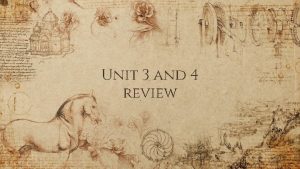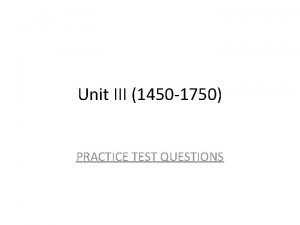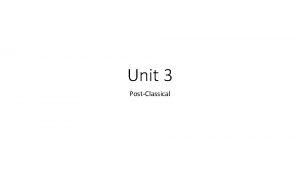REVIEW Unit III The Postclassical Era600 to 1450


























































- Slides: 58

REVIEW Unit III: The Postclassical Era-600 to 1450 Dr. Afxendiou Sachem North High School

PERIODIZATION l Major events and developments that characterize these years as a distinct time period: • Major religions determine and define areas of • the world – Christianity, Hinduism, Confucianism, Buddhism 2 nomadic groups impact history – Bedouins and Mongols

PERIODIZATION l Major events and developments • Islam • Major empires in Mesoamerica and South • • America Chinese hegemony Amount and complexity of trade and contact

REVIEW TOPICS l l l The Islamic World Interregional networks and contacts China’s internal and external expansion European developments The Amerindian World Demographic and environmental changes

THE ISLAMIC WORLD – Dar al-Islam l Islam “submission” • 2 nd largest number of supporters in the world • • today Started in Arabian Peninsula among the Bedouins – nomads who controlled trade routes across the desert. Trade towns linked long caravan routes – Mecca and Medina Mecca also a religious destination due to Ka’aba – contained the black stone

THE ISLAMIC WORLD – Dar al-Islam l Founding of Islam • In Mecca by Muhammad • Muhammad – trader (married to Khadija – • • • wealthy widow). Began to meditate in mountains outside Mecca. Angel Gabriel revealed himself to him. Believed himself to be the last of the prophets of the one true god. Started spreading the new religion Muslims – his followers – people who have submitted to the will of Allah

THE ISLAMIC WORLD – Dar al-Islam l Founding of Islam • • Muhammad’s preaching of monotheism was a thread to the social and economic order – threatened pilgrimage business to Ka’aba 622 hijra (hegira) flight to Yathrib which he remaned Medina – marks the beginning of the Islamic calendar Many converts to Islam – created the community of believers – the Umma Became a political and military leader – 630 captures Mecca, destroys idols around Ka’aba and declares it a holy structure of Allah and the Black stone claimed to be the foundation placed by Abraham in establishing Judaism.

THE ISLAMIC WORLD – Dar al-Islam l Islamic Beliefs and Practices • The Five Pillars • Most important source of religious authority • • • the Qur’an – the actual words of Allah The Sunna – Muhammad’s life, the best model for proper living Shar’ia – body of law based on Qur’an and Sunna, regulated family life, moral conduct, business and community life. All people equal before god

THE ISLAMIC WORLD – Dar al-Islam l The Spread of Islam • 632 Muhammad dies – Islam spread over • • • most of Arabian Peninsula Caliphate – government set up to rule Muslims after Muhammad – theocratic empire Caliph – successor, leader of caliphate and all Muslims – chosen by the leaders of the umma Abu-Bakr-first caliph. Close friend of Muhammad. Followed by 3 other caliphs who also knew Muhammad. These four were known as the “rightly guided” caliphs.

THE ISLAMIC WORLD – Dar al-Islam l The Spread of Islam • Rapid expansion – within 300 years the • Middle East, North Africa and South Asia fell to armies of Islam Spread helped by • weakness of Empires of the time – the Persian and Byzantine Empires • Well-disciplined, well-organized armies • Exclusion of Muslims from taxation – conversion of conquered people in order to avoid taxation

THE ISLAMIC WORLD – Dar al-Islam l Empire grows as religion splits • Sunni-Shi’a split – who should succeed Muhammad • Shi’a-only family members of Muhammad, descendants of Ali should be caliphs • Sunni-any member of umma • Each of the 4 early caliphs was murdered by rivals. Death of Ali triggered a civil war when Umayyad family rose to power (enemies of Muhammad in Mecca)

THE ISLAMIC WORLD – Dar al-Islam l The Golden Age • • • Institutions of higher learning – Cairo, Baghdad, Cordoba Muhammad al-Razi-encyclopedia Preserved learning of ancient Greeks, Romans and Persians – translated writings of Plato and Aristotle into Arabic Language-Umayyads: Arabic; Abbasids: Persian Al-Andalus-Islamic Spain-flowering of culture in otherwise backwards Europe Religion-respect for other religions “dimmis” people of the book; sufis-Islamic mystics

THE ISLAMIC WORLD – Dar al-Islam l Arts, Sciences and Technologies • Art • Science • calligraphy, designs-arabesque • Architecture-minarets, mosques • Literature-Poetic works, A Thousand One Nights • Use of logic – from ancient Greeks • Mathematics from India • algebra • Navigation • Astronomy • Medicine • • Surgery hospitals

THE ISLAMIC WORLD – Dar al-Islam l Women in Islam • Positive elements: • Qur’an changed negative treatment of women in pre-Islamic societies • Treated them with more dignity • Equal before Allah • Dowry returned to wife after divorce • Infanticide forbidden • Gained power within the home • In early stages they had power outside home (Khadijah-Muhammad’s boss)

THE ISLAMIC WORLD – Dar al-Islam l Women in Islam • Negative Elements • Before Islam • Women viewed as property • Man kept dowry after divorce • Female nfanticide • After Islam • Up to 4 wives if a man could afford to support them • patrilineal inheritance • Testimony of woman in court half the weight of man • Veiled in Persia/Mesopotamia later in entire empire • Overtime empire become even more patriarchal

THE ISLAMIC WORLD – Dar al-Islam l Political structures • Umayyad caliphate – Sunnis • Abbasid caliphate • Capital in Damascus • Theocratic rulers • Shi’ites rebelled, overthrew Umayyads and installed • • • Abbasid rulers Initially had Shi’a support but had to bring them under control eventually Capital moved to Baghdad Problems with succession Empire too large to govern High taxes made them unpopular

THE ISLAMIC WORLD – Dar al-Islam l Political Structures • Fall of the Abbasids • Local kingdoms gained power • Sultans – Persian leaders took control of Baghdad in 945 • Seljuk Turks take Baghdad and manipulate caliphs • 1258 Mongols destroy Baghdad

INTERREGIONAL NETWORKS AND CONTACS l Major trade routes • Mediterranean- western Europe, Byzantine • Empire, Islamic Empire Hanseatic League • Baltic/North Sea Regions • Formed in 1241 – 100 cities joined • Silk Road • Trans-Saharan routes – west Africa, Islamic • Empire Indian Ocean trade – Persians, Arabs

INTERREGIONAL NETWORKS AND CONTACS l Cultural Diffusion • Spread of languages and religions • Spread of art and literature • Spread of plague – led to end of European feudal society l Global trade network • Made up of interconnected regions • everyone except Americas involved

INTERREGIONAL NETWORKS AND CONTACS l Trans-Saharan Trade • Ghana – land of gold – 700 s • Mali – replaces and absorbs Ghana – 13 th century • In the savanna region • Gained wealth by taxing goods traders carried through territory • Arab traders spread Islam and expanded knowledge of Africa to world • Gold and salt trade • Islamic • Mansa Musa – pilgrimage • • • Timbuktu Libraries and Islamic schools Mosques

INTERREGIONAL NETWORKS AND CONTACS l Indian Ocean Trade • Different zones dominated by regional powers • West-Arabs • Middle zone-Indian kingdoms • East-China • Reached coast of East Africa – Swahili Coast • Stretched over 6, 000 miles • Used monsoon winds • Intermixing of cultures due to marriage of sailors with local women

INTERREGIONAL NETWORKS AND CONTACS l Indian Ocean Trade • Goods • From Africa-ivory, animal hides, gold, slaves • From Middle East-textiles, carpets, glass, Arabian horses • From India-gems, elephants, salt, cotton cloth, cinnamon • From China-silk, porcelain, paper • From Japan-silver

INTERREGIONAL NETWORKS AND CONTACS l Indian Ocean Trade • China during the Ming dynasty • Made Indian Ocean trade its focus • Expeditions of Zheng He • Chinese junks • Forced to end his expeditions – bureaucrats jealous • of his success New emperor did not want to invest further money – wanted to use money to protect against nomadic invasions – Really?

INTERREGIONAL NETWORKS AND CONTACS l Silk Routes • • • Connected China to Mediterranean since Roman times Used heavily during Mongol rule – 1200 -1600 Products: • Ideas • Silk • Porcelain • Paper • Military technology • Religions-Buddhism, Islam, Christianity • foods

INTERREGIONAL NETWORKS AND CONTACS l The Mongol Empire • • Nomads, great horsemen and archers Genghis Khan-Chinggis Khan Largest empire ever – from Pacific to Eastern Europe Success due to: • Military organization – tjumen • Ruthless warriors, highly mobile-could travel 90 miles • • per day (Romans only 25/day) Bow range 300 yards Motivated soldiers – traitors punished, courage rewarded Used spies Military innovations – in armor, strategies.

INTERREGIONAL NETWORKS AND CONTACS l The Mongol Empire • • • Hordes or Khanates • • Golden horde Great Khanate - included China • Kubilai Khan – created Yuan Dynasty in China • Dismissed Confucian scholars • Kept Mongol and Chinese cultures separate Impact • • Pax Mongolica – trade Exchange of goods, ideas and cultures Silk Road flourished Influenced Russian empire No Golden Age

CHINESE INTERNAL AND EXTERNAL EXPANSION l l China was the richest of the empires of the postclassical time period – the Middle Kingdom Dynasties: • • • Sui Tang Song Yuan Ming

CHINESE INTERNAL AND EXTERNAL EXPANSION l Sui Dynasty, 589 -618 • Ended civil war era that followed the Han • Construction of the Grand Canal • Buddhism adopted by rulers • Rebellions due to unrest caused by natural disasters that led to famine

CHINESE INTERNAL AND EXTERNAL EXPANSION l Tang Dynasty, 618 -907 • accomplishments • Expanded territory to Tibet and into Korea • strong transportation and communications system – Canals, road systems with inns and stables. Courier service connected empire l Song Dynasty 960 – 1279 • Weaker than Tang • Conflict with northern neighbors

CHINESE INTERNAL AND EXTERNAL EXPANSION l Tang/Song Dynasties • Stable bureaucratic system based on civil service exam (started during Han dynasty) • Confucian principles • Scholar gentry • Meritocracy not aristocracy • New business practices • Paper money • Flying money-letters of credit

CHINESE INTERNAL AND EXTERNAL EXPANSION l Tang/Song Dynasties • New technologies • Gunpowder for military use • Junks • Magnetic compass • Block printing • Trade • Involved in regional trade with Southeast Asia and Pacific Coast – sea routes • Silk Road with Asia • Network of road and canals connect North and South regions

CHINESE INTERNAL AND EXTERNAL EXPANSION l Tang/Song Dynasties • Agriculture • Champa Rice – Vietnam • New agricultural techniques • Increased production leads to increased population from 45 to 115 million leads to urbanization (growth of cities) especially in the South. • More production needed for increased population, drain swamp land, terrace hillsides

CHINESE INTERNAL AND EXTERNAL EXPANSION l Tang/Song Dynasties • Social Changes • In all areas – art, science, philosophy, porcelain making, silk weaving, transportation systems • Tang – poetry • Song – printing – expanded literacy • Women • Empress Wu – first empress, supported Buddhism • Inferior • Song – footbinding • Power of upper class women through males – sons or as favorites of rulers

CHINESE INTERNAL AND EXTERNAL EXPANSION l Tang/Song Dynasties • Religion • Buddhism - Greatest influence by outside religion • State sponsored during Sui • Favored in the beginning of Tang (Empress Wu) • Mahayana Buddhism – followed by the masses, mystical, • emphasis on quiet and peaceful existence • Chan Buddhism (Zen in Japan) – followed by elite. Focus on meditation. Confucian Reaction • Bureaucrats threatened by its popularity • Seen as economic drain to national treasury (no taxes) • monasteries destroyed-Buddhism never regained power

CHINESE INTERNAL AND EXTERNAL EXPANSION l Tang/Song Dynasties • Art – stylized and symbolic landscape • paintings by scholar-gentry Philosophy – Neo-Confucianism • Used ancient Confucian texts • Codified traditional Chinese philosophy • Reinforced gender and class distinctions

CHINESE INTERNAL AND EXTERNAL EXPANSION l Chinese Influence on surrounding areas • Tributary states • Japan • Korea • Vietnam • Kow-tow • Intensification of ethnocentrism

CHINESE INTERNAL AND EXTERNAL EXPANSION l Japan • • • 4 main islands (archipelago) Relative isolation but influenced by China throughout Political • • Emperor descendant of Yamato Clan (no dynastic cycle) During Tang Dynasty heavily influenced by China • • Taika Reforms • Chinese characters (didn’t work) • Buddhism • Court etiquette • Chinese architecture • Confucian classics • Bureaucratic government organization • Law codes • Tax system • Art, literature, music Emperor attempted to establish scholar gentry – resisted by aristocracy

CHINESE INTERNAL AND EXTERNAL EXPANSION l Japan • • • After 794 increased aristocratic power, the emperor becomes a figurehead Division into small territories ruled by powerful clans with private armies 1192 the Shogun becomes the political leaderbeginning of Japanese feudal system • Gempei Wars- peasants v. Samurai • Military state • Damyo – huge landowner-controls Samurai • Divides land to lesser vassals and Samurai • Peasants exist to serve samurai

CHINESE INTERNAL AND EXTERNAL EXPANSION l Japan • Social • Early religion – Shinto • Kami • Emperor descendant of spirit of emperor sun goddess • Buddhism gained hold but Shintoism remained • Literature – • Poetry written by men • Prose women – Lady Murasaki Tale of Genji

CHINESE INTERNAL AND EXTERNAL EXPANSION l Japan • Social • Women • • Noblewomen educated No freedoms • Loyalty, courage, honor • • Ink sketches Tea ceremony – tranquility, ritual Decorative gardens – importance of nature Haiku verses – simplicity, peacefulness, enlightenment • Code of Bushido – way of the warrior • Art

CHINESE INTERNAL AND EXTERNAL EXPANSION l Korea • • Peninsula, bridge between China and Japan Political • Captured by Tang who withdraw in return for tribute payments • Silla kingdom a vassal of China • Economic • Social • Participated in Chinese trading network • Adapted Chinese writing • Scholars trained in Confucian classics • Art- porcelain manufactured improved Chinese methods – Celadon bowls (pale green color)

CHINESE INTERNAL AND EXTERNAL EXPANSION l Vietnam • South of China • Political • Valued their independence, not willing to become tributaries • Made up of small kingdoms – the Khmer the strongest • Periodically absorbed into China but always resisted

CHINESE INTERNAL AND EXTERNAL EXPANSION l Vietnam • Social • Accepted some Chinese traditions • Agriculture and irrigation • Veneration of ancestors • Women • Had more autonomy than women in other Asian • • cultures Trung sisters – led revolt against Chinese Had economic roles in local commerce

CHINESE INTERNAL AND EXTERNAL EXPANSION l Yuan Dynasty • • Mongols in China 1271 Kubilai Khan Religious tolerance but end of civil service exams Kubilai Khan keeps Mongols separate from Chinese to maintain culture Mongol women have more freedoms than Chinese women Foreigners used in government positions (Marco Polo) Merchants gained status Attempted to capture Japan (failed both times – Kamikaze)

CHINESE INTERNAL AND EXTERNAL EXPANSION l Ming Dynasty • Overthrew Yuan Dynasty • See Indian Ocean trade information

EUROPEAN DEVELOPMENTS l l Fall of Rome - Western Europe and Byzantine Empire WESTERN EUROPE • • • 500 – 1000 The Dark Ages 1000 – 1300 The High Middle Ages Dark Ages – loss of • Need for protection – Vikings, Magyars (8 th & 9 th centuries) led to rise of feudalism • Roman civilization • written language • complex government

EUROPEAN DEVELOPMENTS l WESTERN EUROPE • Feudalism-social and political system • Lords, vassals, knights – land for service and loyalty • Fiefs • Status defined by birth • Power based on how much land you control • Code of Chivalry • Decentralized government – local rule on the manor • Local power struggles – “feuds” (feudalism)

EUROPEAN DEVELOPMENTS l WESTERN EUROPE • Manorialism- economic system • manors - self-sufficient • Serfdom • Crude tools – 9 th century the moldboard • Weakened by Crusades and increase of trade and rise of towns • Destroyed by Black Plague

EUROPEAN DEVELOPMENTS l Western Europe • Women • Traditional roles – home/children • Peasant women work in fields • Code of Chivalry reinforces idea of women as weak, subordinate, in need of protection • Alternative to traditional roles - the convent • Women in towns can participate in trade and be members of guilds • Cannot inherit • Education limited to domestic skills

EUROPEAN DEVELOPMENTS l WESTERN EUROPE • Crusades 11 th – 13 th centuries • Pope Urban II • Free the Holy Land from Muslim control • Initial success but ultimately failed to achieve goal • Brought Europe into the major world trade routes of the time – Mediterranean trade, Silk Road • Europe changed by encounter with Middle East – new products, new technologies, new ideas • Demand foreign products created in Europe • Venice and Genoa – rich trade cities – geographic location

EUROPEAN DEVELOPMENTS l WESTERN EUROPE • Crusades • 4 th crusade raided Constantinople – undermining of Byzantine • • Empire Power of kings increases – they gain the right to tax for armies Beginning of Muslim/Christian hostilities Increased Eurasian trade Growth of banking Creation of urban middle class Renewal of economy, learning, arts Move towards centralized political authority Import of new military technology – guns and cannons – castles and knights are obsolete

EUROPEAN DEVELOPMENTS l WESTERN EUROPE • Black Plague – the tiny flea topples feudal/manorial system • Comes from Asia through trade routes – Chinese or Mongol origin? • Labor shortage • Labor of serfs valuable in cities – leave the manor

EUROPEAN DEVELOPMENTS l WESTERN EUROPE • Economic developments • Social developments • Rise of towns • Use of money (move away from barter) • Banking system, credit system, insurance • Towns regulate their businesses and collect own taxes • guilds • Universities in High Middle Ages • Gothic Architecture

EUROPEAN DEVELOPMENTS l WESTERN EUROPE • England • Norman invasion 1066 – William the Conqueror • Alternative feudalism – all vassals owe allegiance to king • Bureaucracy, single system of laws • Parliamentary government – unique to England • Places limitations on king • Magna Carta – • no taxation without consent • No arbitrary arrest • King is not above the law

EUROPEAN DEVELOPMENTS l WESTERN EUROPE • Hundred Years’ War – 1337 – 1453 • France v. England • Long bow • Peasant armies • Knights made obsolete • end of Medieval period

EUROPEAN DEVELOPMENTS l BYZANTINE EMPIRE • Established by emperor Constantine – • • Eastern Roman Empire Capital Constantinople Strategic position between Black Sea and Mediterranean Lasted 1000 years after fall of Rome Christian theocracy – absolute rule

EUROPEAN DEVELOPMENTS l BYZANTINE EMPIRE • Adapted Greek language • Blended Greek and Roman cultures • Art- iconography • Architecture – the dome • Emperor Justinian • Justinian Code – legal system based on Roman 12 Tables of Law • Hagia Sophia

EUROPEAN DEVELOPMENTS l The Great Schism - 1054 • Christianity of Western Europe and Christianity of Eastern Europe • Roman Catholicism and Christian Orthodoxy • Differences: • Communion • Priests and marriage • Language and church ceremonies • Byzantines did not want papal interference
 Ap world history period 3
Ap world history period 3 Unit 10, unit 10 review tests, unit 10 general test
Unit 10, unit 10 review tests, unit 10 general test Hamlet act iii scene ii
Hamlet act iii scene ii Unit 1 test algebra 2 answers
Unit 1 test algebra 2 answers Mughal empire 1450 to 1750
Mughal empire 1450 to 1750 1450 ad
1450 ad Kznu radio
Kznu radio Fur trade 1450 to 1750
Fur trade 1450 to 1750 Russian empire 1450-1750
Russian empire 1450-1750 Saq examples
Saq examples Land based empires 1450 to 1750
Land based empires 1450 to 1750 500/1450
500/1450 Global tapestry definition
Global tapestry definition Japan 1450-1750
Japan 1450-1750 World map 1450
World map 1450 Europe 1450
Europe 1450 1900-1450
1900-1450 C-1450-2
C-1450-2 1250 bc
1250 bc 2300-1450
2300-1450 Europe 1450
Europe 1450 Toreador fresco meaning
Toreador fresco meaning Religion in 1450 to 1750
Religion in 1450 to 1750 Southeast asia 1450 to 1750
Southeast asia 1450 to 1750 St basil's cathedral ap world history
St basil's cathedral ap world history Renaissance 1450 to 1600
Renaissance 1450 to 1600 Historischer hintergrund naturalismus
Historischer hintergrund naturalismus Change analysis chart 1450 to 1750
Change analysis chart 1450 to 1750 Hình ảnh bộ gõ cơ thể búng tay
Hình ảnh bộ gõ cơ thể búng tay Lp html
Lp html Bổ thể
Bổ thể Tỉ lệ cơ thể trẻ em
Tỉ lệ cơ thể trẻ em Chó sói
Chó sói Glasgow thang điểm
Glasgow thang điểm Hát lên người ơi alleluia
Hát lên người ơi alleluia Môn thể thao bắt đầu bằng từ đua
Môn thể thao bắt đầu bằng từ đua Thế nào là hệ số cao nhất
Thế nào là hệ số cao nhất Các châu lục và đại dương trên thế giới
Các châu lục và đại dương trên thế giới Công thức tính thế năng
Công thức tính thế năng Trời xanh đây là của chúng ta thể thơ
Trời xanh đây là của chúng ta thể thơ Mật thư anh em như thể tay chân
Mật thư anh em như thể tay chân 101012 bằng
101012 bằng độ dài liên kết
độ dài liên kết Các châu lục và đại dương trên thế giới
Các châu lục và đại dương trên thế giới Thể thơ truyền thống
Thể thơ truyền thống Quá trình desamine hóa có thể tạo ra
Quá trình desamine hóa có thể tạo ra Một số thể thơ truyền thống
Một số thể thơ truyền thống Cái miệng xinh xinh thế chỉ nói điều hay thôi
Cái miệng xinh xinh thế chỉ nói điều hay thôi Vẽ hình chiếu vuông góc của vật thể sau
Vẽ hình chiếu vuông góc của vật thể sau Thế nào là sự mỏi cơ
Thế nào là sự mỏi cơ đặc điểm cơ thể của người tối cổ
đặc điểm cơ thể của người tối cổ Ví dụ về giọng cùng tên
Ví dụ về giọng cùng tên Vẽ hình chiếu đứng bằng cạnh của vật thể
Vẽ hình chiếu đứng bằng cạnh của vật thể Fecboak
Fecboak Thẻ vin
Thẻ vin đại từ thay thế
đại từ thay thế điện thế nghỉ
điện thế nghỉ Tư thế ngồi viết
Tư thế ngồi viết Diễn thế sinh thái là
Diễn thế sinh thái là





